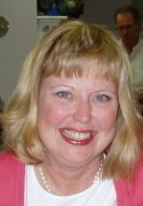 Michelle Kirkhoff didn't begin her career focusing on transportation and air quality, but in an effort to better her education, fate stepped in and led her to travel a different highway. Now the MSRC, SANBAG and the region are all better off, thanks to her tireless work in the transportation sector for the last 22 years.
Michelle Kirkhoff didn't begin her career focusing on transportation and air quality, but in an effort to better her education, fate stepped in and led her to travel a different highway. Now the MSRC, SANBAG and the region are all better off, thanks to her tireless work in the transportation sector for the last 22 years.
Michelle's undergraduate degree is in music therapy and she began her career working in psychiatric hospitals using music, recreation and art as a medium to help improve her patients' mental health. After seven years, she wanted to transition into management, so she went back to school at Cal State Fullerton to get her MBA. There, she met Ellen Burton who worked for the Orange County Transit District (OCTD). Open to changing her career path and at Ellen's urging, Michelle went to work for the OCTD in 1988. Michelle later introduced Ellen to her husband and joked, "so Ellen helped me find my job, and I helped her find her husband. It really is all about who you know."
As the OCTD evolved into the Orange County Transportation Authority (OCTA), Michelle also adapted with the changing roles she served at the OCTA over the years. "All of my projects had revenue, planning, and implementation components, so I treated each project like a business unit. I couldnt have done it without my business degree," Michelle said. Michelle moved around internally working in areas such as ridesharing and special projects for the Director of Transit, when she eventually was recruited to work for the OCTA's new grants and revenue division. This happened to be a year after the MSRC was formed, so since she was heading up the grants department, she was the ideal choice to represent the OCTA on the MSRC's Technical Advisory Committee (TAC). She was the OCTA's representative to the TAC for five years and also served as its Vice Chair from 1993-1995.
How Michelle got to the San Bernardino Associated Governments (SANBAG) was also a twist of fate. She started ski patrolling in Big Bear and jokingly commented to Eric Haley, who worked for SANBAG at the time and whom she met through her work with the MSRC, that they should hire her so she could live in Big Bear. Eric told her that they needed someone like Michelle at SANBAG, a position was created for her, and she's been there ever since. "I got to SANBAG through my relationships from the MSRC - usually it's the other way around," Michelle remarked. Michelle has been with SANBAG since 1995 and is the Director of Air Quality and Mobility Programs.
Serving on the TAC and working with the MSRC are activities that she enjoys, which is why she's been there since practically the beginning. "The MSRC provides a chance to work on regional projects with cities, counties, and commissions that you might otherwise not get to work with. I've developed such wonderful relationships over the years - it's a great family. I like going to meetings so I can catch up with everyone," she said. Michelle also said that she always learns something new at the TAC meetings, so they are a great source of information for her. As a representative of SANBAG, Michelle served as Vice Chair of the TAC from 1996-1998, and Chair from 1998-2000.
Michelle sees the role of the TAC as helping to do critical staff work for the MSRC. "The TAC is the eyes and ears for the Committee to flesh out technical, contractual, and policy issues, clean them up and present them in a nice package to the MSRC." In her view, the MSRC is so unique because it has such a small staff, and everyone volunteers from their respective agencies who come from different perspectives, but all work so well together. "It keeps it interesting to have such a strong, tight committee and I'm very proud of it," she said. "Plus, it's fun to represent your agency's interests and issues in such a collaborative setting."
The MSRC is also unique because it is the only committee of its kind in the state, and probably the country, Michelle noted. "That we are able to make decisions so effectively and help to fund projects that reduce mobile source emissions is an amazing accomplishment in a government setting. In fact, I've had other air districts and agencies from across the state and the country contact me and ask for guidance on how we do things."
Michelle reflected on how meaningful the work of the MSRC has been over the last two decades "As other grant programs have gotten more competitive and have imposed stringent cost-effectiveness requirements, many cities and counties weren't able to compete for these sources of funding, so the MSRC became crucial in helping these cities and counties move forward with their innovative clean air projects. The Local Governments' portion of AB 2766 funding alone wasn't enough to keep them investing in new technologies - they needed the MSRC, and we were happy to serve them and still are."
As for the future, Michelle looks at the air quality commitments that have come with the new federal administration as well as expanding state support, and sees that the MSRC also will get credit for reducing greenhouse gas pollutants. "If the MSRC continues to focus on criteria pollutants as it has in the past, greenhouse gases will be a side benefit to those emission reductions. The whole world is now behind these initiatives, so it's exciting to look at what's out there and what's coming," she explained.
Photos,
Middle photo: Michelle believes in all forms of zero-emission vehicles -- here she is kayaking in Alaska
Bottom photo: Michelle with former MSRC Chairs John Longville and Will Kleindienst and former TAC member Marilyn Williams accepting an award on behalf of RCTC and SANBAG in 1996.
